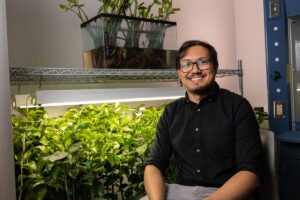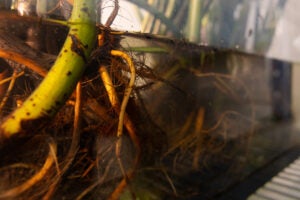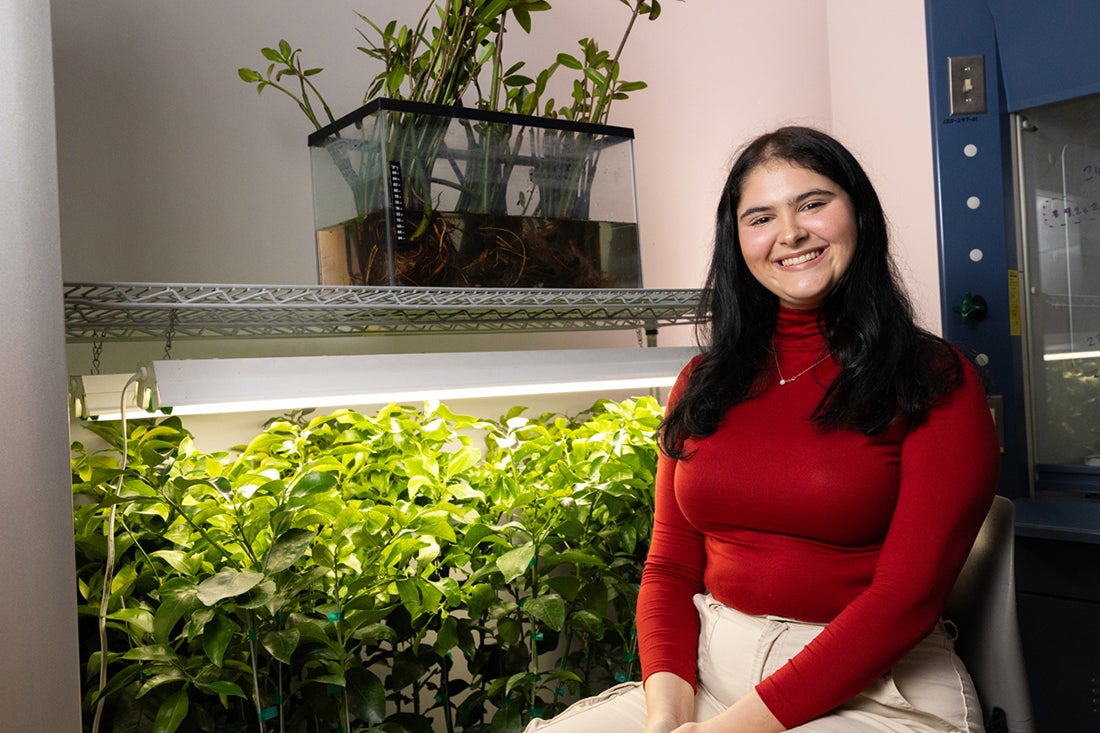Mangroves and palm trees are hallmarks of the Sunshine State not just for their beauty but for their immense importance to Florida’s coastlines.
Mangroves are crucial because they naturally protect coastal shores from storm damage and serve as vital wildlife habitats around the world.
Scientists at the University of Central Florida are working to preserve mangroves in Florida and across the world from an increasingly prevalent disease-causing variety of fungi that lies dormant but become active when the tree is exposed to stressors such as temperature fluctuation, pests or other diseases.
The disease does not yet have an official name, but it is being referred to by scientists as “Mangrove CNP.” It is caused by a group of fungal pathogens, including Curvularia, Neopestalotiopsis, and Pestalotiopsis, that causes yellowing and spots, and gradually weaken the mangrove until it ultimately dies.
Melissa Deinys, a UCF undergraduate researcher, and Jorge Pereira, a UCF graduate research assistant, are working to help turn the tide by developing and testing a promising nutritional cocktail comprised of nanoparticles to strengthen mangroves and counter the pathogens. The work is through UCF professor Swadeshmukul Santra’s Materials Innovation for Sustainable Agriculture (MISA) center at UCF, which is a U.S. Department of Agriculture-National Institute of Food and Agricultural recognized Center of Excellence.
Mangrove CNP in Florida was first identified as causing mangrove die-offs by Deinys in 2019 in Miami through her work with Fairchild Tropical Botanic Garden. Later, the Marine Resources Council, a non-profit organization dedicated to the protection and restoration of Florida’s Indian River Lagoon, verified and cited her efforts.
Deinys and collaborators with the MRC and Fairchild Tropical Botanic Garden have determined that about 80% of the mangroves they had sampled have tested positive for at least one of the fungal pathogen species. She says they have sampled over 130 mangroves between the Indian River Lagoon and Miami mangrove populations.

The researchers are treating the mangroves by soaking them in a nutrient solution called “Mag Sun” (MgSuN), which is comprised of magnesium and sulfur nanoparticles. The mixture is a refinement of a previous graduate student’s formula that destroyed bacteria on tomatoes, Pereira says.
“The reason why we choose magnesium is because it is more environmentally friendly, and plants need a lot of magnesium,” he says. “I combined our magnesium formulation with a sodium polysulfide. Sulfur is one of those elements that is ubiquitous in the environment, and the idea is that you can combine both to actually enhance the anti-microbial capacity for both bacteria and fungi and you also supply key nutrients to the plants so that they can grow greener and leafier.”
During lab tests, the researchers say they observed growth inhibition of up to 95% when treated with MgSuN at varying concentrations compared to the untreated control.
The formula acts as a sort of antibiotic and multivitamin, and it has shown great potential in bolstering the health of infected mangroves at nurseries across Florida, Pereira says.
“We’ve done some experiments, and we have tested both in vitro and in plants,” he says. “We’re working with the nurseries, and we’ve seen it does kill the pathogens with no detrimental effects to the mangroves while kickstarting their health. They look great after treatment.”
Deinys is continuing her work with the Fairchild Tropical Botanic Garden, MRC and nurseries across Florida while staying the course on her path to graduation and furthering her research at UCF.
She began studying the fungal pathogens in 2018 in Miami prior to being enrolled at UCF and has seen the mangroves become increasingly affected by the pathogens’ opportunistic nature.
“Back at the botanical gardens where I started, I would see the plants have these pathogens but not to a detrimental effect where we now see these organisms collapsing,” she says. “A mangrove nursery [The Marine Resources Council] had reached out to us, and they told us they had an insect infestation and then the whole population got wiped out by the pathogen. We’re also getting reports from places like Tampa that say areas that have more runoff are having more pathogen-related deterioration compared to 10 years ago.”
The fungi have been well-documented for some time, but volatile temperature changes, frequent storms and other increasing stressors open the door to the fungi taking a hold of the mangroves, Deinys says.
“They’re called opportunistic, and they’re called that for a reason,” she says. “They see a change in the plant and that’s when they start to take effect.”
How the pathogens are acquired is something that remains unclear, Deinys says. Researchers hypothesize it may be introduced through water, wind or insects, but further studies are needed to determine how it is acquired since it poses threat to mangrove health.
“You have to study all possibilities to determine what is the vector,” Deinys says. “We’ve seen papers and literature in other countries that have shown these pathogens for a long time. It’s been difficult because there is a disconnect in mangrove communities because we’re worlds apart and with different languages.”

The MgSuN nutrient solution is a treatment, but not a cure, Deinys says. There still are ample stressors that should be managed and mitigated, such as human-caused habitat destruction, in addition to treating the pathogens.
“I think there’s a big restoration effort to repopulate mangroves,” she says. “But first we need to look at the health of these mangroves and the health of the ecosystem before we determine what more we should do. We’re working with mangrove nurseries to see if we can together develop solutions.”
Maintaining and restoring mangroves is an essential component of ecological stewardship, and it’s a passion that Deinys hopes to continue throughout her career.
“I started this project my freshman year,” she says. “I didn’t want to leave what I was doing, and I came here with a mission. I met with Dr. Santra, our PI, and he wanted to help. He gave me a lot of freedom, and I’m really grateful.”
Deinys says that her research at UCF has been incredibly gratifying.
“There is a sense of community here that I found,” she says. “I joined the lab, and it felt like I found my family and that’s one of the best things to have come out of this experience. This has been one of my life’s passions, and I hope I’ll always stay with this project even after.”
Santra is encouraged by the research conducted by Pereira and Deinys, and he is hopeful it continues to bolster mangrove ecosystems.
“The UCF MISA center is dedicated to solving global problems that threaten agricultural sustainability,” he says. “We are excited to have another crop protection tool in our toolbox for protecting mangroves. I see the future of MagSun as a broad-spectrum fungicide, where GRAS (Generally Recognized As Safe) materials are empowered through nanotechnology.”
Further studies are needed to pinpoint which stressors are affecting the mangroves the most so that scientists can better preserve them, Pereira says.
“It’s very important to understand the stressors, and we need to really address if it’s a change in temperature, if it’s runoff or if it’s an additional pathogen,” he says. “In the meantime, we need to do something to prevent this damage from occurring.”
Researchers’ Credentials
Deinys graduated from BioTECH @ Richmond Heights High School, a conservation biology magnet school, where she began her research journey at Fairchild Tropical Botanic Garden and specialized in botany. In Fall 2022, Deinys joined UCF and became a member of the Santra Lab the following spring. She is an undergraduate research assistant working towards her bachelor’s degree in biotechnology.
Pereira graduated from Universidad Nacional Autónoma de Honduras with a degree in industrial chemistry. He joined Santra’s lab in 2020 and is currently a graduate research assistant and working toward his doctoral degree in chemistry.
Santra holds a doctorate in chemistry from the Indian Institute of Technology Kanpur. After graduating, he worked at the University of Florida (UF) as a postdoctoral researcher and later as a research assistant professor at the UF Department of Neurological Surgery and Particle Engineering Research Center. In 2005, Santra joined UCF as an assistant professor at the NanoScience Technology Center, the Department of Chemistry and the Burnett School of Biomedical Sciences. He is the director of the UCF Materials Innovation for Sustainable Agriculture center, a USDA-NIFA-recognized Center of Excellence.




